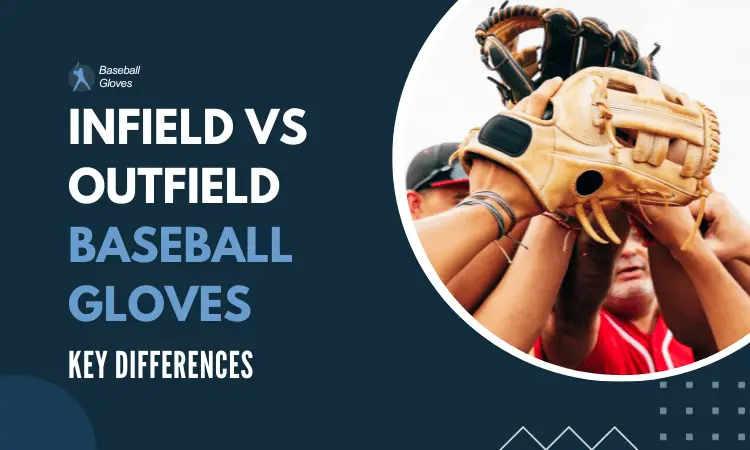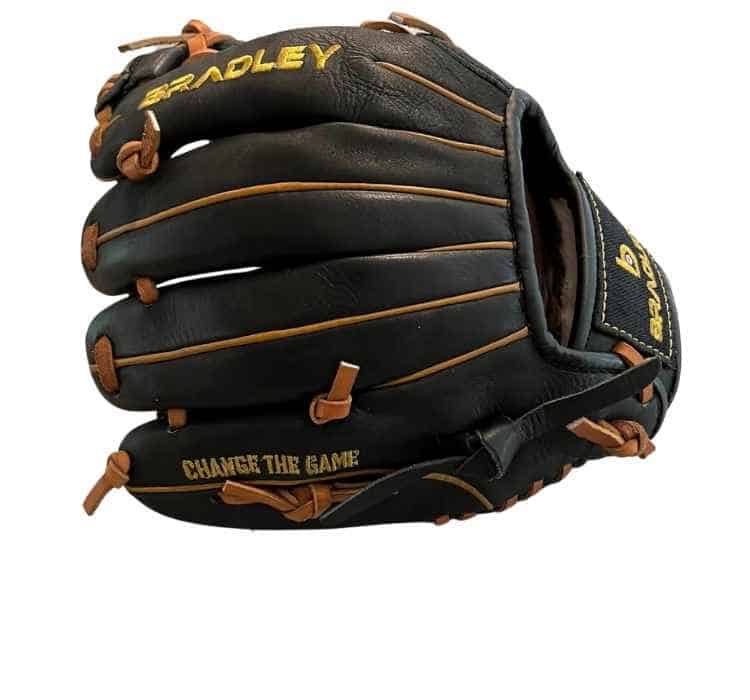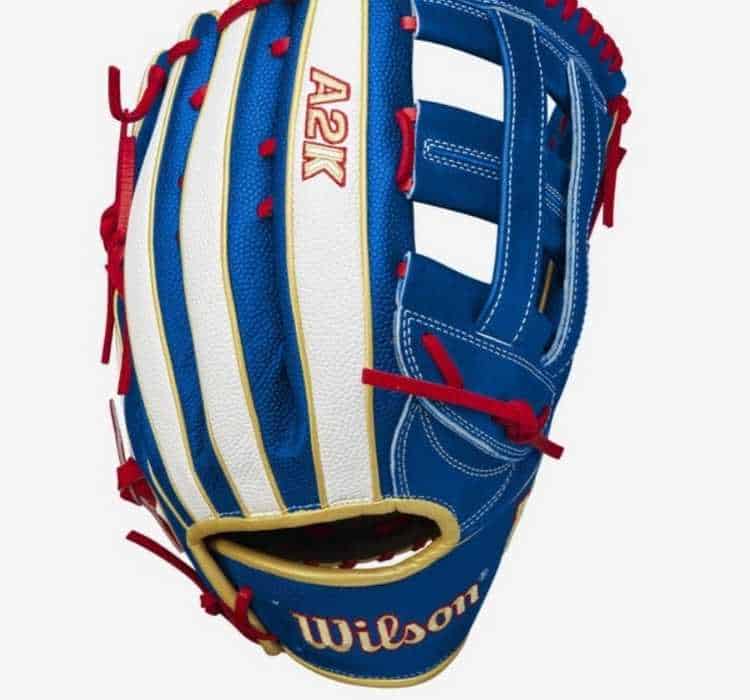Are you making the same mistake over and over by getting the wrong glove? Believe me. You are not alone!
At first, all the gloves look the same. But the more you look, the more confused you get, especially if you are new to this.
You may be wondering- why is that so? Simple. There are different categories of baseball gloves. And here’s the kicker. Within those categories, there are many variations. Hence, the confusion.
So, to ease things up once and for all, I have divided and categorized the features of both the infield and the outfield baseball gloves. Hopefully, this will help you recognize which one’s which.

Infield Vs Outfield Baseball Gloves
Infield Vs Outfield Baseball Gloves
Let’s cut to the chase. When you are trying to differentiate between the two gloves, you need to keep an eye out for a few key details such as – pocket depth, weight, length, back design, style, and webbing.
So, for the next few minutes, you can forget about getting the best baseball gloves and redirect your focus to the following features.


Pocket Depth
The pocket is the part that has the indentation of the palm. The depth of the pocket matters a great deal when it comes to the position of the players.
Shallow Pockets
Infielders prefer five-fingered gloves that have a shallow pocket. This helps them for a quick transfer and release, thus, enabling them for fast plays.
Deep Pockets
The outfield players are the farthest ones from the ball. So, if there are any pop-flys, hard-hits, or fly balls, the extra depth helps them to grab the ball properly and prevent them from bouncing off. They can also make long throws into the infield.
Size (Infield vs Outfield)
Finding the right size is quite tricky, especially when there are a lot of variables to deal with. For example, there is a range for every age group, but if your child’s hands are big, then you would have to opt for a bigger size.
Infielders make quick turnaround plays which involve a lot of fast movements and quick transitions from catching the ball and then throwing it. This is only possible if the weight of the glove is less.
That’s why infield gloves are lighter, smaller, and have shallow pockets, whereas outfield gloves are noticeably longer, heavier, and have deeper pockets.
| Glove Size(inches) | Age | Infield | Outfield |
| 9” | Below 8 years old | Infield | – |
| 11” | Below 8 years old | – | Outfield |
| 9”-10” | Between 8-13 years old | Infield | – |
| 11”-12” | Between 8-13 years old | – | Outfield |
| 10.5”-11.5” | Adult (above 14 years) | Infield | – |
| 12”-13” | Adult (above 14 years) | – | Outfield |


Back design – this is the wrist closure. There are two types- open and closed.
Open Back Gloves
These are flexible. There is a space right above the wrist adjustment area. They are ideal for infield players because they provide more mobility and allow quick turnarounds.
Close Back Gloves
There is no space above the adjustment. Some of them may have a finger hole where the index finger can rest. These are best suited for outfield players.
Webbings (Infield vs. Outfield)
Both the infielder and outfielder players prefer open web gloves. But there are different types of webbing, and each type serves its own purpose. And at times, there are some that are used by both infielders and outfielders.
So let me organize it for you a little.
Trapeze Web:
The trapeze webbing has a leather strap that is interlaced on both sides. This creates more depth in the pocket which is ideal for outfielders to catch fly balls.
I-Web:
The I-Web, where the leather posts are sewn in the shape of ‘I’. This is quite favorable for infielders as the debris and dirt fall through the gaps in the webbing, and the player can quickly transfer the ball.
H-web + Modified Trapeze:
Now, for the ones that are used by both the infielders and outfielders. There are two types- modified trap and the H-web. The modified trap is quite similar to that of the trapeze, except that it has an additional leather strip at the top of the web. This provides more stability.
As for the H-web, the leather posts form ‘H-shaped patterns. Similar to the I-web, the dirt falls through the gaps. However, this design is sturdier, so you can catch the hard-hit balls. Also, it expands the catch radius of the first baseman. The third baseman also prefers this type of webbing.
Styles (Infield vs. Outfield)
As you can see, there is a fair amount of distinction between the infield and outfield gloves. Although the latter doesn’t differ based on the position of the player, the former has a few variations.
For instance, the first baseman has to catch a number of balls that come in at high velocity. That’s why they use a mitt instead of a glove. Their mitts are bigger, more padded, and naturally, heavier than other infield gloves. So, if you are getting an infield glove, make that you get the right one.
Let me give you the gist.
First Base Mitt
As I mentioned before, the mitt is bigger, but it has a shallow pocket which aids the first baseman to quickly catch the ball. This glove is quite similar to that of a catcher’s mitt, but it has less padding.
Middle Infield Glove
It’s a five-fingered glove. And it is relatively smaller in size, which allows the player to have better control over their movements.
Third Base Glove
The player is in a defensive position, so the gloves are larger. Getting the right size of baseball glove is quite important to ensure proper fielding.
Features
| Infield Glove | Outfield Glove |
| Smaller, add speed and flexibility | Larger and longer |
| Closed webbing glove for third base for extra support against hard-hit balls | Trapeze, modified trap, and I-web gloves for catching pop flys and hard-hits |
| Open webbing glove for a shortstop, first and second basemen for quick transfer | Open webbing allows a clear view of the ball and blocks out the sunlight |
| Shallow pockets for fast catches and quick throws | Deep pockets for catching the ball |
Related Questions
I’ll just answer some of the most common questions people have about infield and outfield gloves.
What Size Glove Is Better for Shortstop or Second Base?
The middle infield glove is the smallest glove in comparison to others. For adults, the glove size ranges from 11- 11 ½ inches. But some may even prefer 11 ¾ inches. It depends on how you wear the glove and how comfortable you are.
There are two ways of wearing the glove. Some prefer to wear the glove by putting the ring finger and pinky in the pinky hole for better control. It also gives the illusion of a deeper pocket. But there’s an issue with this technique. Sometimes the ball can get stuck in the glove, and that’s something that you don’t want.
Others prefer putting each finger in their respective holes. This also gives you better control, but the pocket is flatter. And your fingers don’t cramp up.
How Can I Measure My Baseball Glove Properly?
There’s a simple way. If you want to figure out the length of the glove, look at either the thumb or the pinky, the size is usually printed there. If it is missing, then you can take a fabric tape measure and take the measurement from the top of the index finger and go down along the length of the glove and stop right at the center of the heel.
Can You Use an Infield Glove as an Alternative for The Outfield?
No. You can, but it’ll really mess your game up. The role of an infielder is different from that of an outfielder; that’s why the size, webbing, and pocket depth of their gloves are different. That’s why it’s best to buy gloves that serve the right purpose rather than interchanging them.
Are Outfield Gloves Bigger Than Infield Gloves?
Yes. Outfield gloves are bigger than infield ones. They are longer with extra padding and have deep pockets. This provides the player with more range, and they can cover a large space.
Which Is the Hardest Position in Baseball?
According to the general census, it’s usually the shortstop that is considered the most difficult position on the field. When the player is on the baseball diamond playing shortstop, they have to cover a lot of ground. They need to be swift in their maneuvers and may, at times, have to go to the outfield in the case of short-fly balls.
Wrapping Up
It’s quite often that we forget about looking into the specs of a product, especially when we see a sale on a popular brand. But if you are not getting the right pair of gloves with the proper fit and one that is perfect for the player’s position, you are fighting a losing battle.
So, if you are getting it for your child, confirm their position in the game first- is it infield or outfield? If it is infield, is it first baseman, middle infield, or third baseman? Then, let them try on the gloves at the store and see if it is the right fit. Ask them if the webbing and the padding are fine. If all is well, then you make the purchase. Hope this article was helpful. Cheers!
